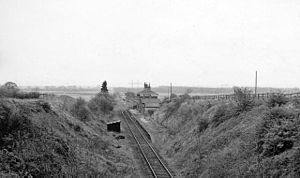Pilmoor, Boroughbridge and Knaresborough Railway
| Pilmoor, Boroughbridge and Knaresborough Railway | |
|---|---|

Remains of Brafferton station in 1961
|
|
| Overview | |
| Type | Heavy Rail |
| Status | Closed |
| Locale | North Yorkshire |
| Termini | Knaresborough, North Yorkshire Pilmoor Junction (East Coast Main Line), North Yorkshire |
| Operation | |
| Opened | 1847 |
| Closed | 1964 |
| Operator(s) |
North Eastern Railway London North Eastern Railway British Rail |
| Technical | |
| Number of tracks | 1 |
| Track gauge | 4 ft 8 1⁄2 in (1,435 mm) |
| Pilmoor, Boroughbridge and Knaresborough Railway |
||||||||||||||||||||||||||||||||||||||||||||||||||||||||
|---|---|---|---|---|---|---|---|---|---|---|---|---|---|---|---|---|---|---|---|---|---|---|---|---|---|---|---|---|---|---|---|---|---|---|---|---|---|---|---|---|---|---|---|---|---|---|---|---|---|---|---|---|---|---|---|---|
|
||||||||||||||||||||||||||||||||||||||||||||||||||||||||
The Pilmoor, Boroughbridge and Knaresborough Railway was a railway line in North Yorkshire, England, that connected Pilmoor on the East Coast Main Line with the towns of Boroughbridge and Knaresborough.
The line originally ran only between Pilmoor and Boroughbridge from its opening in 1847 until 1875 when the section from Boroughbridge to Knaresborough opened. When the line to Knaresborough was being surveyed, it was determined that there would not be enough clearance over the roads to Dishforth and Catterick Bridge, so a spur was built just north of Boroughbridge station which allowed the line the space to gain enough height to clear these roads. This necessitated moving Boroughbridge station onto the new formation.
Shortly after the Second World War, a rail connected depot for the Air Ministry was opened between Brafferton and Pilmoor. The section from Pilmoor to the Air Ministry siding was removed in 1953.
The line had three intermediate stations, at Brafferton, Boroughbridge and Staveley. The station at Staveley was called Copgrove and Staveley on its opening in 1875. It was renamed Copgrove in 1881 after the nearby Copgrove village to avoid confusion with Staveley in Derbyshire.
An attempt was made to cut costs in 1936, for the 3 to 6 trains a day, by replacing traditional signalling with staff and ticket at all stations. The line closed for passengers in 1950 and for goods in 1964. Pilmoor station closed on 5 May 1958.
...
Wikipedia
